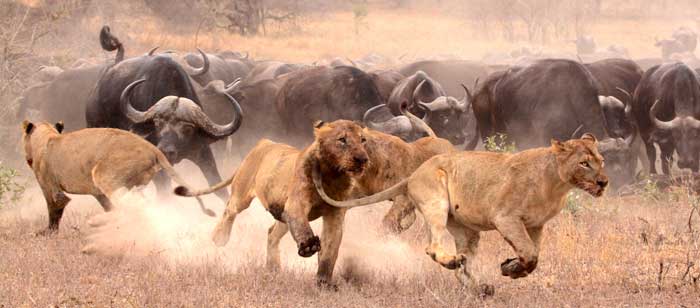The lion kill rate varies so much that there is no standard or average. My source tells me that the reported kill rate ‘of individual lions varies from a low of ten to twelve prey per year to a high of forty-seven. To try and work out a standard success rate across all lion prides in all places is foolhardy and misleading. (Wild Cats of the World).

The same source states that in certain locations they can provide averages for certain prey animals such as follows:
- In Etosha National Park lions have an average kill rate of a successful kill every 6.7 hunts. This is a 15% success rate.
- In the same reserve, the zebra capture rate was 11%.
- For wildebeest it was 30%.
- For springhare the success rate is 52% from twenty-seven hunts.
- In other places the success rates varied from 21 to 38.5%.
The success or failure of a hunt depends on:
- Vegetation height;
- Prey behaviour;
- The lunar phase (i.e., the amount of light projected from the moon). They prefer darkness;
A pride of lions can have success one week and failure the next. For example, one group consisting of two adults with several one-year-old cubs made only one significant kill of a zebra foal during a two-week period but during another two-week period the same group killed at a far greater frequency.
A conservationist, Van Orsdol, studied lions and their hunting success and failures. He examined two areas to see the effects of lion group size, prey group size, the lunar phase and the extent of cover on hunting success. In one area, Mweya, the grass was 5 cm tall and did not provide stalking cover. The prey density was low. Lions watched for warthogs and other prey that was easy to catch during daytime rest periods. They were alert to hunting opportunities when they rested during the day. They were able to find food without actively searching. At night they moved around hunting for larger prey animals.
In another area, Ishasha, there was cover as the vegetation was taller. The prey density was about four times higher. The lions hunted mainly on moonless nights when they had greater hunting success.
The overall success rate did not vary much between these two areas. In Mweya the success rate was 27.1%. That means that in 27.1% of hunts they managed to kill a prey animal. In the Ishasha area the success rate was 30.5%.
My source of information says that “in comparison with other felids, lions are generally more successful hunters” but they have to share their kills with other pride members which impacts upon whether they obtain their minimum daily requirement of 5-8.5 kg of meat per lioness per day.
I will add some information from the internet for completeness:
- The top website as found by Google search says that the lion kill rate is 25%. A bold statement seeing as it is so variable;
- The Roaring Earth website says that the lion kill rate is between 17-19% when hunting solo.
I will stop there as the second item introduces another variable; they mention hunting solo and lions hunt solo or in groups which affects success rates.

Below are some more pages on lion attack.

